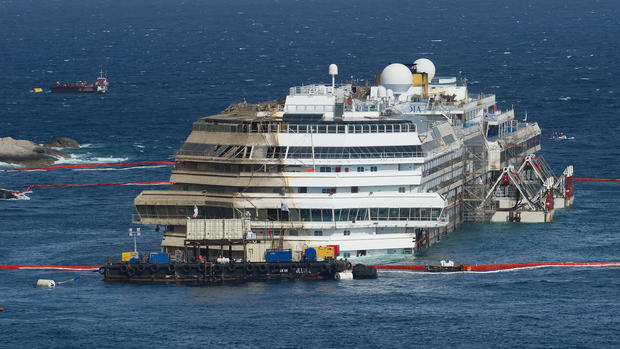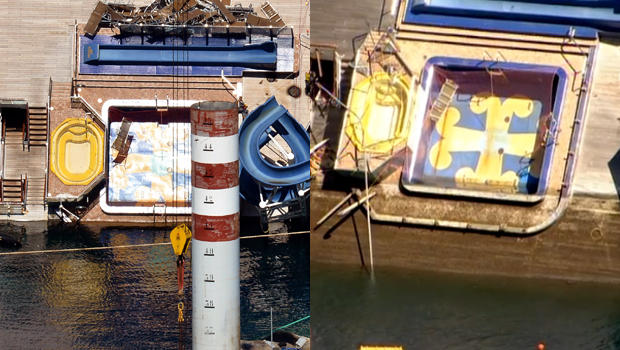Costa Concordia freed from reef, engineers say
Last Updated 3:27 p.m. ET
GIGLIO ISLAND, Italy In an unprecedented maritime salvage operation, engineers on Monday gingerly wrestled the hull of the shipwrecked Costa Concordia off the Italian reef where the cruise ship has been stuck since January 2012.
But progress in pulling the heavily listing luxury liner to an upright position was slower than expected. Delays meant the delicate operation — originally scheduled from dawn to dusk Monday — was not expected to be completed before Tuesday morning.
"Things are going like they should, but on a timetable that is dragging out," Franco Gabrielli, head of Italy's Civil Protection Agency, said Monday evening.
Never before has such an enormous cruise ship been righted.
An early morning storm delayed the salvage command barge from getting into place for several hours. Later, some of the cables dragging the ship's hull upright went slack, forcing engineers to climb the hull to fix them.
The crippled Concordia wouldn't budge for some three hours after the operation to right it -- known in nautical parlance as "parbuckling" -- began at around 9:00 a.m. local time, engineer Sergio Girotto told reporters.
But after some 6,000 tons of force were applied -- using a complex system of pulleys and counterweights -- Girotto said "we saw the detachment" from the reef thanks to undersea cameras.
He said the cameras did not immediately reveal any sign of the two bodies that were never recovered from among the 32 people who died Jan. 13, 2012, when the Concordia slammed into a reef and toppled half-submerged on its side after coming too close to Giglio Island.
Images transmitted Monday by robotic diving vehicles indicated that the submerged side of the cruise ship's hull had suffered "great deformation" from all its time on the granite seabed, battered by waves and compressed under the weight of the ship's 115,000 tons, Girotto said.
The goal is to raise the ship 65 degrees to a vertical position, for eventual towing. The initial operation to lift the Concordia from the reef moved the ship just 3 degrees toward vertical. While a seemingly small shift, the movement was significant enough to be visible: A few feet of slime-covered ship that had been underwater slowly became visible above the waterline.
The entire rotation was originally expected to last as long as 12 hours. But as evening approached, work was clearly falling behind schedule. Some seven hours after the rotation attempt began, the Concordia had moved upward only by a total of 10 degrees.
"It's taking longer than expected," Girotto said in a late afternoon briefing. "Even if it's 15 to 18 hours, we're OK with that. We are happy with the way things are going."
Officials stressed that so far no appreciable pollution from inside the ship had spewed out. Giglio is part of a Tuscan archipelago in a marine sanctuary where dolphins and fish are plentiful.
- Huge salvage operation to turn the Costa Concordia
- Costa Concordia: Salvaging a shipwreck
- Grounded Costa Concordia cruise ship is ready to roll, literally
- Tragic final moments of passengers revealed in new Costa Concordia file
Parbuckling is a proven method to raise capsized vessels; it was used on the USS Oklahoma in 1943 after the Japanese attack on Pearl Harbor. But the 1,000-foot Concordia has been described as the largest cruise ship ever to capsize and subsequently require the complex rotation.
The Costa Concordia is around two-and-a-half times the size of the Titanic, and no one wants to see it split apart, reports CBS News' Sabina Castelfranco.
The operation has attracted crowds of tourists and media, waiting to see the ship lifted.
"From what I can see it's moving bit by bit, it's raised about a meter and half from the sea level," said one of the tourists gathered on the harbor wall to watch it slowly rise out of the water.
Few of the locals will ever forget the night the Costa Concordia struck rocks. There was a mad rush to provide assistance to the thousands fleeing the ship. The harsh reality that 32 people lost their lives in the disaster still haunts many of them.
Two bodies are still missing, and their families are hopeful they will now be found.
Since the tragedy, the people of Giglio have watched their island's port transform itself into a work-in-progress area for an unprecedented salvage operation.
A 500-member international team of engineers and mechanics has worked tirelessly for months with one goal in mind: removing the 114,500-ton ship firmly stuck to two outcrops of rock on the seabed.
But it's a hugely complex operation and not one that is without risks. It is those risks that most concern the locals at this time.
They have been assured that all calculations have been made and nothing has been left to chance, but these islanders are concerned. Everyone is aware there are still 237.5 cubic meters of polluted water inside the ship, which could cause significant environmental damage to Giglio's pristine waters.
Additional emergency vehicles have arrived on the island, and as extra precaution, inflatable pollution barriers and fishing nets have been put up around the wreck and along the shoreline, in an effort to hold back any debris or oil that will spew from the Concordia as she turns.
The green light was given to its rotation after it became clear the ship could not remain in its current position another winter.
Nick Sloane, the South African senior salvage master of the operation and project leader for contractors Titan Salvage, said the Concordia would suffer an extreme amount of force of compression in the first moments of the maneuver. But he expressed confidence that the huge cruise ship will survive the stress. And it did.
With the eyes of the world focused on Giglio, Sloane -- who has three decades of experience -- candidly admits this is an extraordinary project which has pooled together the very best engineers and expertise from around the world.
"The size of the ship and her location make this the most challenging operation I've ever been involved in," he said.
As the operation continued, twelve experts were in the control room positioned at the bow of the ship, anxiously staring at their computer screens and listening for every noise the wreck made.
At a rate of three meters per hours, dozens of crank-like pulleys were to start slowly rotating the ship. Steel chains weighing 17,000 tons have been looped under the vessel to help hold it together and pull it upright. Also, tanks, known as sponsons, will be filled with water on the port (exposed) side to help rotate it upward.
A massive grouting mattress has been created on the seabed between the two outcrops of rock to provide greater stability to the ship.
"The objective is to get her to move very slowly and gently," Sloane said.
Once the ship moves upward about 25 degrees, "at that point gravity takes over, and there is no going back."
Once the ship is pulled upright, an in-depth survey will be carried out to establish the extent of the damage on the starboard side.
The re-floating of the Concordia is not expected before the spring of 2014. Then, it will need to be towed to the mainland. But its final port of destination -- where it will be cut up for scrap -- is still to be decided.
Complete CBSNews.com coverage: Costa Concordia disaster
Kevin Rebello, whose brother Russel was a waiter on the ship and was never found, said he was in constant touch with the project managers as he monitored news reports of today's operation.
"I haven't slept since yesterday," he told The Associated Press in an interview in Rome. "It's taken 20 months. If it takes another 20 hours, for me it's worth the wait."
Rebello plans to travel to Giglio Island on Tuesday, even though he knows there's no certainty his brother's remains will be found. His hope is that someday he can bring his brother home to Mumbai "to give him a decent burial.
"That's what me, my family, his wife and all of us are hoping for," he said.
The Concordia's captain is on trial on the mainland for alleged manslaughter, causing a shipwreck and abandoning the ship during the chaotic and delayed evacuation. Capt. Francesco Schettino claims the reef wasn't on the nautical charts for the liner's weeklong Mediterranean cruise.
Costa Crociere SpA, the Italian unit of Miami-based Carnival Corp., is picking up the tab for the parbuckling and its intricate preparation. The company puts the costs so far at 600 million euros ($800 million), though much of that will be passed onto its insurers.
Despite the disaster, locals have come to appreciate the crews who have spent more than a year working on the wreckage, renting out hotel rooms and vacation apartments that would otherwise have gone vacant during the winter.
Giovanni Andolfi, a 63-year-old resident who spent his career at sea, called the crews "the best brains in the field." But he was eager to see them finish.
"I would like Giglio to return to what it was before, a beautiful place of uncontaminated nature," he said.



